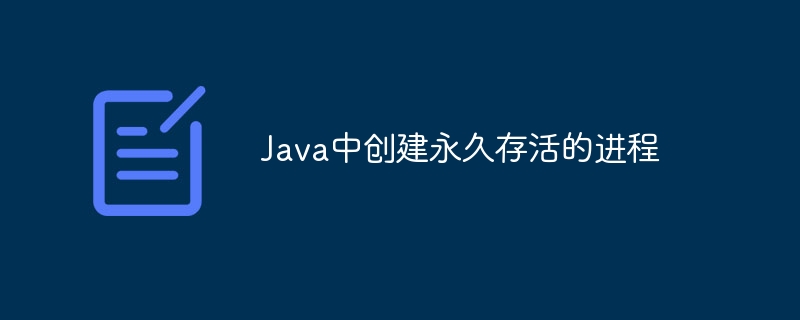Java如何创建无限运行进程
时间:2025-07-30 21:39:35 432浏览 收藏
本文深入探讨了在Java程序中如何创建并维持一个永不终止的命令行进程,旨在解决开发者在实际应用中遇到的进程意外终止问题。通过分析现有代码的缺陷,明确了`PrintWriter`在循环内关闭导致子进程终止的原因,并提供了将`PrintWriter`移至循环外部、利用`inheritIO()`简化输入输出流管理、以及采用后台线程异步处理输入输出流等多种解决方案。这些方法不仅能确保子进程在Java应用程序的整个生命周期内稳定运行,还能有效避免资源泄露和死锁的发生。本文是Java开发者构建长期运行进程的实用指南,重点在于输入输出流的正确管理和资源释放,助力打造更健壮的Java应用。

本文旨在解决Java程序中创建并维持一个长期运行的命令行进程的问题。通过分析现有代码中进程意外终止的原因,并提供修改后的代码示例,演示了如何正确地与子进程进行输入输出交互,从而确保子进程在整个Java应用程序生命周期内保持运行。本文提供了避免资源泄露和死锁的关键实践,并探讨了使用后台线程处理输入输出流的替代方案。
在Java程序中创建并维持一个长期运行的命令行进程,需要特别注意进程的输入输出流管理。如果处理不当,子进程可能会意外终止,或者导致程序死锁。以下是如何解决这个问题的详细步骤和示例代码。
问题分析
原始代码中,子进程在第一次迭代后终止,这是因为PrintWriter stdin 被放置在 while 循环内的 try-with-resources 块中。这意味着每次循环迭代结束时,stdin 都会被关闭,从而关闭了子进程的标准输入流。当子进程的标准输入流关闭时,cmd.exe 也会随之终止。
解决方案
要解决这个问题,需要确保子进程的标准输入流在整个Java应用程序的生命周期内保持打开状态。以下是一些可行的解决方案:
将 PrintWriter 移到循环外部
将 PrintWriter 的声明和初始化移到 while 循环外部,以确保它在整个循环过程中保持打开状态。
class CommandLine { Process Handle; Scanner getCommand; Socket socket; PrintWriter stdin; // 声明 PrintWriter 在循环外部 public CommandLine(Socket socket) throws IOException { this.socket = socket; } public void executeCommand() { try { getCommand = new Scanner(socket.getInputStream()).useDelimiter("\\A"); Handle = new ProcessBuilder("cmd.exe").redirectErrorStream(true).start(); stdin = new PrintWriter(Handle.getOutputStream()); // 初始化 PrintWriter 在循环外部 while (getCommand.hasNextLine()) { try { stdin.write(getCommand.nextLine() + System.lineSeparator()); stdin.flush(); } catch (Exception e) { e.printStackTrace(); // 处理写入错误 break; // 退出循环,避免无限重试 } if (Handle.getInputStream().available() > 0) { // 使用 available() 检查是否有数据可读 Scanner result = new Scanner(Handle.getInputStream()).useDelimiter("\\A"); while (result.hasNextLine()) { System.out.print(result.nextLine() + "\n"); } } } } catch (IOException e) { e.printStackTrace(); } finally { // 确保资源被正确关闭 if (stdin != null) { stdin.close(); } if (Handle != null) { Handle.destroy(); // 确保进程被销毁 } } } }注意事项:
- 在 finally 块中关闭 stdin 和销毁 Handle,以确保资源被正确释放,即使发生异常。
- 使用 Handle.getInputStream().available() > 0 来检查输入流中是否有数据可读,避免阻塞。
- 添加异常处理机制,捕获写入输入流时可能发生的异常,并适当地处理。
使用 inheritIO() 或 redirectOutput(ProcessBuilder.Redirect.INHERIT)
使用 ProcessBuilder.inheritIO() 或 ProcessBuilder.redirectOutput(ProcessBuilder.Redirect.INHERIT) 可以将子进程的标准输入、输出和错误流重定向到 Java 进程。这样就不需要手动读取和写入流。
class CommandLine { Process Handle; Scanner getCommand; Socket socket; public CommandLine(Socket socket) throws IOException { this.socket = socket; } public void executeCommand() { try { getCommand = new Scanner(socket.getInputStream()).useDelimiter("\\A"); Handle = new ProcessBuilder("cmd.exe").inheritIO().start(); // 使用 inheritIO() //Handle = new ProcessBuilder("cmd.exe").redirectOutput(ProcessBuilder.Redirect.INHERIT).redirectError(ProcessBuilder.Redirect.INHERIT).start(); // 或者使用 redirectOutput 和 redirectError try (PrintWriter stdin = new PrintWriter(Handle.getOutputStream())) { while (getCommand.hasNextLine()) { stdin.write(getCommand.nextLine() + System.lineSeparator()); stdin.flush(); } } } catch (IOException e) { e.printStackTrace(); } finally { if (Handle != null) { Handle.destroy(); } } } }注意事项:
- 使用 inheritIO() 后,子进程的输出会直接显示在 Java 进程的控制台上。
- 如果需要分别处理子进程的输出和错误流,可以使用 redirectOutput 和 redirectError。
使用后台线程处理输入输出流
为了避免阻塞主线程,可以使用后台线程来处理子进程的输入和输出流。
import java.io.*; import java.net.Socket; import java.util.Scanner; import java.util.concurrent.ExecutorService; import java.util.concurrent.Executors; class CommandLine { Process Handle; Scanner getCommand; Socket socket; private final ExecutorService executor = Executors.newFixedThreadPool(2); // 创建线程池 public CommandLine(Socket socket) throws IOException { this.socket = socket; } public void executeCommand() { try { getCommand = new Scanner(socket.getInputStream()).useDelimiter("\\A"); Handle = new ProcessBuilder("cmd.exe").redirectErrorStream(true).start(); // 启动线程读取子进程的输出 executor.submit(() -> { try (Scanner result = new Scanner(Handle.getInputStream()).useDelimiter("\\A")) { while (result.hasNextLine()) { System.out.println(result.nextLine()); } } catch (Exception e) { e.printStackTrace(); } }); // 主线程负责写入子进程的输入 try (PrintWriter stdin = new PrintWriter(Handle.getOutputStream())) { while (getCommand.hasNextLine()) { stdin.write(getCommand.nextLine() + System.lineSeparator()); stdin.flush(); } } Handle.waitFor(); // 等待子进程完成 } catch (IOException | InterruptedException e) { e.printStackTrace(); } finally { executor.shutdown(); // 关闭线程池 if (Handle != null) { Handle.destroy(); } } } }注意事项:
- 使用 ExecutorService 创建线程池来管理线程。
- 使用 Handle.waitFor() 等待子进程完成,避免过早退出。
- 在 finally 块中关闭线程池和销毁进程。
总结
在Java中创建永久存活的进程,关键在于正确管理子进程的输入输出流。避免在循环内部关闭输入流,使用 inheritIO() 或后台线程处理输入输出流,可以确保子进程在整个Java应用程序的生命周期内保持运行。同时,要记得在程序结束时关闭流和销毁进程,以避免资源泄露。
到这里,我们也就讲完了《Java如何创建无限运行进程》的内容了。个人认为,基础知识的学习和巩固,是为了更好的将其运用到项目中,欢迎关注golang学习网公众号,带你了解更多关于的知识点!
-
501 收藏
-
501 收藏
-
501 收藏
-
501 收藏
-
501 收藏
-
469 收藏
-
500 收藏
-
465 收藏
-
104 收藏
-
403 收藏
-
323 收藏
-
424 收藏
-
127 收藏
-
290 收藏
-
321 收藏
-
213 收藏
-
355 收藏
-

- 前端进阶之JavaScript设计模式
- 设计模式是开发人员在软件开发过程中面临一般问题时的解决方案,代表了最佳的实践。本课程的主打内容包括JS常见设计模式以及具体应用场景,打造一站式知识长龙服务,适合有JS基础的同学学习。
- 立即学习 543次学习
-

- GO语言核心编程课程
- 本课程采用真实案例,全面具体可落地,从理论到实践,一步一步将GO核心编程技术、编程思想、底层实现融会贯通,使学习者贴近时代脉搏,做IT互联网时代的弄潮儿。
- 立即学习 516次学习
-

- 简单聊聊mysql8与网络通信
- 如有问题加微信:Le-studyg;在课程中,我们将首先介绍MySQL8的新特性,包括性能优化、安全增强、新数据类型等,帮助学生快速熟悉MySQL8的最新功能。接着,我们将深入解析MySQL的网络通信机制,包括协议、连接管理、数据传输等,让
- 立即学习 500次学习
-

- JavaScript正则表达式基础与实战
- 在任何一门编程语言中,正则表达式,都是一项重要的知识,它提供了高效的字符串匹配与捕获机制,可以极大的简化程序设计。
- 立即学习 487次学习
-

- 从零制作响应式网站—Grid布局
- 本系列教程将展示从零制作一个假想的网络科技公司官网,分为导航,轮播,关于我们,成功案例,服务流程,团队介绍,数据部分,公司动态,底部信息等内容区块。网站整体采用CSSGrid布局,支持响应式,有流畅过渡和展现动画。
- 立即学习 485次学习
